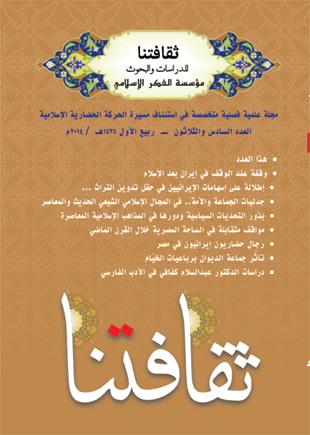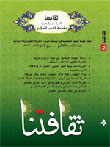فهرست مطالب

فصلنامه ثقافتنا
پیاپی 36 (1392)
- تاریخ انتشار: 1392/07/15
- تعداد عناوین: 9
-
صفحه 7
-
صفحه 129
-
صفحه 163
-
Page 9Waqf (inalienable endowment) tradition is one of the greatest manifestations of Islamic culture and civilization which enjoys a superb position in Iran. Among other Islamic traditions, Waqf is a voluntary and benevolent task which can be useful in improving public services level and economic welfare of the society, if it follows a proper approach. There are numerous examples of endowment of properties for public works including constructing libraries, schools, hospitals, etc. throughout Iran.
-
Page 25Thanks to the Iranian-Arabic civil unity, Persian and Arabic have become the key languages of the Islamic heritage. Iranian writers were used to set down their works in both Persian and Arabic. There were writers who initially wrote their books in Arabic and then translated them to Persian in order to allow other Iranians who didn’t know Arabic could use the books. Hence, correcting such books needs a broad knowledge on both languages. Both Iranian correctors and some orientalists are skilled in this field.
-
Page 43There is a deep difference between concept of tribe and Ummah, as the former directs us to debates on nations, sects, movements, etc. while the latter concentrates on unity and civilization. In comparison to the “tribe” thinking “Ummah” thinking can benefit all Islamic tribes and sects. Shia governments have started numerous efforts to invite all Muslims to unity in the contemporary era. Such efforts can be seen in the Seyed Jamal al-Din Assadabadi’s life, Islamic Revolution of Iran and plans advocating the proximity of Islamic Schools of Thought in Iran, Iraq and Lebanon.
-
Page 69Analyzing the seditions among the Islamic religions is impossible without considering the backwardness condition of the Muslim World. The backwardness reasons cannot be illuminated without considering the historical condition. This article tries to examine the condition briefly. Then the revivers’ plots to cure the condition are offered. Likewise, a number of the lost opportunities to get rid of the backwardness are considered. The current facts as well as our suggestions to put an end to disasters of the Muslim World are either offered.
-
Page 97This article deals with briefly the confrontation between Laic and Islamic currents’ thoughts in the second half of 20th century. There were many debates on concepts of Laic, democracy, socialism and capitalism. Likewise, there were fervent discussions on the eligible political system, identity and how to improve the system as well as the national identity of Egyptians. A number of issues such as the relation between Islam and nationality, understanding the religion in terms of the time requirements and the relationship between Islamic religions were considered. The current discussion in fact is the complement of an article, Egyptian Cultural Conversations in the Past Century, printed in our volume no.
-
Page 129Emergence of Iranian characters who invited people to unity and civilization in Egypt is a manifestation of the unity in the Muslim World. Relying on an infra-nationality and infra-religious discourse, they tried to revive the concept of the unified Muslim Ummah. The article analyzes three outstanding Iranian characters: Seyed Jamal al-Din Assadabadi, Sheikh Abdolkarim Zanjani and Sheikh Muhammad Taghi Qomi. They were welcomed by Al-Azhar scholars and they started a friendly cooperation which still is seen.
-
Page 163Jamaat divan was a literal movement in Egypt whose key characters were Aghad, Shokri and Mazeni. They were influenced by Khayyam’s poems translated in English by Edward Fitzgerald. They translated Khayyam’s poems into Arabic in both prose and poem and also wrote several articles on Khayyam’s thoughts.This article evaluates their translations through comparing them with both English and Persian texts.
-
Page 191Abdosalam Kafafi is a writer and researcher on the Egyptian comparative literature who has recently started to compare Persian and Arabic literature. He has studied The Panchatantra and its translation from Sanskrit to Persian and then to Arabic. He also has discussed very precisely about the story and Layla and Majnun, Yusuf and Zulaikha in both Arabic and Persian texts. He also studied different poetry styles in Persian and Arabic.


